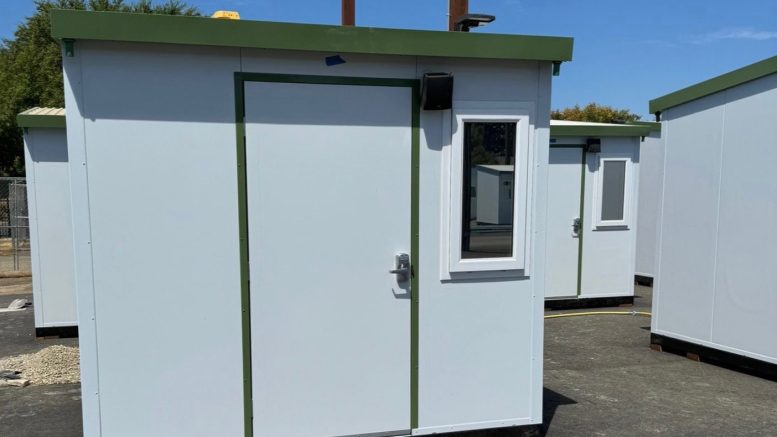By Russell Nichols
As California continues to face an epic homelessness crisis, Sacramento County has a sliver of good news: The number of people experiencing unsheltered homelessness has decreased by 41% since 2022, according to the recent Point-in-Time count.
But the overall numbers are still higher than 2019 levels, due in part to rising rents, stagnant wages, lasting impacts of the pandemic and a lack of affordable housing. For many advocates, the mission is as solid as a Lego block: get people off the streets and into stable environments ASAP. While it can take five or more years to build permanent homes, interim housing has popped up around the state as a critical stopgap solution.
With nearly 4,000 people still without shelter in Sacramento, these scalable options have become not only valuable but vital, according to Elizabeth Funk, founder and CEO of DignityMoves, a nonprofit focused on interim housing solutions to address unsheltered homelessness.
“The common argument has been: anything you’re spending money on that is not permanent is a waste of resources,” she says. “We’re arguing the opposite. Our goal is to get people indoors and stabilized so they can rebuild their lives, which they can’t do from the street.”
As California lawmakers push for Senate Bill 1395, the Interim Supportive Housing Act, to fast-track setting up interim housing and extend the Shelter Crisis Act past January 2026, advocates point out that interim housing has a key advantage: versatility. From tiny homes to modular units, they say, these cost-effective, lockable-door options can be built quickly and offer a more dignified living experience than large, warehouse-style shelters.
That said, scaling up interim housing calls for careful maneuvering around complex policies, securing funding, navigating community resistance and getting jurisdictions on board. In July, Gov. Gavin Newsom issued an executive order directing state agencies and departments to “address dangerous encampments” while supporting and assisting the individuals living in them through local policies and intervention programs.
On Aug. 27, Newsom signed two new bills — Assembly Bill 2835 and 3057 — to address homelessness and expand options across the state. These new laws make slight tweaks to current policies. For instance, AB 2835 lets motels and hotels keep housing people short-term without the usual tenant protections that kick in after 30 days. AB 3057 speeds up the approval process for building junior accessory dwelling units (small backyard homes), making it easier to create more affordable living spaces.
“The biggest thing holding us back from solving unsheltered homelessness is people don’t think it’s possible,” Funk says. “But we’re spending twice as much money not solving it.”
Temporary solutions have appeared in various forms. In 2023, Robin Moore, founder and CEO of WEforce of California Inc., began putting tiny homes in her Sacramento backyards as transitional housing to support unhoused families. In August, Azure Printed Homes, based in Southern California, showcased its 3D-printed tiny homes made from recycled bottles at the state capitol. The company has at least one new project in the bidding process in Sacramento and hasn’t run into issues with regulatory restrictions, according to co-founder Gene Eidelman.
Factory inspections and approvals for ADUs and tiny homes are moving faster than on-site builds, Eidelman adds. Decreasing interest rates are making these projects more affordable, and shipping costs are improving too, thanks to lower gas prices and more trucking availability, he says.
Locally, the push for interim housing is already in motion, like off Stockton Boulevard where a 175-bed interim Stay Safe Community is underway. Modular units have been set up, including single cabins with a few doubles for couples. Facilities will include a laundry building, restrooms and showers and, eventually, a large, multi-purpose building for food storage and meetings.
The state-approved cabins feature fire-retardant panels made from 30% recycled plastic, created by BOSS Cubez, based in Los Angeles County. With a background in building materials, CEO Viken Ohanesian started his business about four years ago, seeing an opportunity to use his company’s resources to help.
“Just like every community needs a hospital and fire station,” he says, “every community needs interim housing that will help people who have fallen off track get on their feet and into society.”
The site is located on property owned by nonprofit WellSpace Health, which bought the land and leased space for the village to Sacramento County, according to Stephen Watters, founder and executive director of First Step Communities, a nonprofit organization that creates interim housing communities and a Stockton Boulevard Plan partner. Sacramento County has contracted First Step Communities to administer the program at Safe Stay Stockton, he adds.
The integration of health support is critical, says Watters, who founded his organization in 2015. He believes any housing is better than no housing. But he finds interim housing provides better support and programs by offering individuals privacy and direct access to resources.
“My personal opinion is when we put people directly into permanent housing, it can be tough to succeed,” Watters says, adding that interim housing programs and services can prepare individuals for success in employment, housing and social situations. “People come to us stressed, suffering from the effects of trauma, and it’s beneficial to be able to go to your own room and close the door and have a little privacy and dignity. I think it’s a big part of the healing process.”
This story is part of the Solving Sacramento journalism collaborative. Solving Sacramento is supported by funding from the James Irvine Foundation and the James B. McClatchy Foundation. Our partners include California Groundbreakers, Capital Public Radio, Outword, Russian America Media, Sacramento Business Journal, Sacramento News & Review, Sacramento Observer and Univision 19. Sign up for our monthly newsletter.


Be the first to comment on "A push for interim housing could help Sacramento’s unhoused "